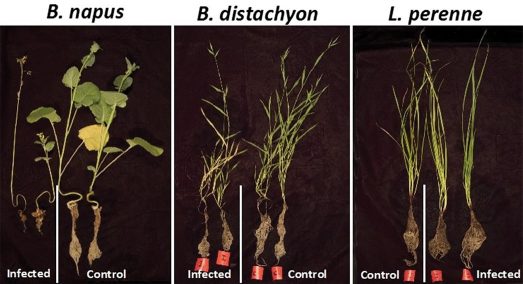Looking for clubroot resistance in non-host plants
Key result: A grass plant called B. distachyon can get infected with clubroot, but secondary gall-forming infection will not occur. While this might show promise, the study concluded that looking for resistance in host brassica species is the better path for now.
Project title, Principal investigator: “Using Non-host Species to Identify Novel Genes For Durable Clubroot Resistance in Canola,” Peta Bonham-Smith, University of Saskatchewan
Funding: Growing Foward 2, SaskCanola and Saskatchewan’s Agriculture Development Fund (ADF)
Plasmodiophora brassicae, the pathogen that causes clubroot in species of the Brassicaceae family, including canola, has a complex life cycle comprised of several major stages. This includes survival of resting spores in the soil, primary infection of root hairs, and secondary infection which leads to the eventual release of resting spores back into the soil. Current clubroot-resistant (CR) varieties allow for the primary infection to occur, but prevent the secondary zoospores from infecting the plant. These varieties were developed as a result of identifying clubroot resistance genes in susceptible species of Brassicaceae. While they have been a very useful part of clubroot management, they only protect against specific P. brassicae pathotypes and no resistance genes protect against all pathotypes.
This study investigates the use of a non-host species as a potential source of more durable, broad-spectrum resistance genes that could protect against multiple pathotypes. The non-host species that was utilized was Brachypodium distachyon, a wild grass species used as a model plant for temperate grasses. The intention in this project was to verify if B. distachyon could act as a non-host species for P. brassicae infection and subsequent clubroot development and to profile the transcriptome (all the messenger RNA molecules expressed from the genes) of the pathogen and of the non-host plant during infection to identify non-host plant genes likely involved in the mechanism of disease prevention.
By using both light and electron microscopy, Bonham-Smith’s research team found that B. distachyon allowed for the primary infection to occur but it prevented the secondary infection from ensuing (and therefore did not produce root galls), thereby preventing the establishment and progression of clubroot disease. The resistance, seen as a significant regression of the number of infected cells in the root inner tissues, develops in the non-host plant within a few days after the infection. This suggests that B. distachyon was able to recognize and either eliminate the pathogen from the plant or to prevent the completion of the pathogen life cycle, confirming that B. distachyon is a non-host and does not develop clubroot.
Utilizing the B. distachyon complete genome sequence, they carried out transcriptome sequencing to recognize the genomic differences between the susceptible and the non-host resistant plants (in order to identify the molecular basis of resistance to secondary infection by P. brassicae). Comparative heat map analyses of the transcriptomes showed that both B. distachyon and P. brassicae transcript levels demonstrated very
little difference between infected and mock-infected
(B. distachyon) plants.
Without fully understanding the interactions between P. brassicae and host plants, it is very difficult to understand this non-host interaction, particularly in light of very little genome activity from both the non-host and the pathogen. Therefore, it is recommended that research on the compatible host-pathogen system is a higher priority for the identification of plant resistance than understanding non-host systems.






